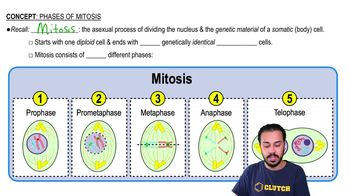Table of contents
- 1. Introduction to Biology2h 40m
- 2. Chemistry3h 40m
- 3. Water1h 26m
- 4. Biomolecules2h 23m
- 5. Cell Components2h 26m
- 6. The Membrane2h 31m
- 7. Energy and Metabolism2h 0m
- 8. Respiration2h 40m
- 9. Photosynthesis2h 49m
- 10. Cell Signaling59m
- 11. Cell Division2h 47m
- 12. Meiosis2h 0m
- 13. Mendelian Genetics4h 41m
- Introduction to Mendel's Experiments7m
- Genotype vs. Phenotype17m
- Punnett Squares13m
- Mendel's Experiments26m
- Mendel's Laws18m
- Monohybrid Crosses16m
- Test Crosses14m
- Dihybrid Crosses20m
- Punnett Square Probability26m
- Incomplete Dominance vs. Codominance20m
- Epistasis7m
- Non-Mendelian Genetics12m
- Pedigrees6m
- Autosomal Inheritance21m
- Sex-Linked Inheritance43m
- X-Inactivation9m
- 14. DNA Synthesis2h 27m
- 15. Gene Expression3h 20m
- 16. Regulation of Expression3h 31m
- Introduction to Regulation of Gene Expression13m
- Prokaryotic Gene Regulation via Operons27m
- The Lac Operon21m
- Glucose's Impact on Lac Operon25m
- The Trp Operon20m
- Review of the Lac Operon & Trp Operon11m
- Introduction to Eukaryotic Gene Regulation9m
- Eukaryotic Chromatin Modifications16m
- Eukaryotic Transcriptional Control22m
- Eukaryotic Post-Transcriptional Regulation28m
- Eukaryotic Post-Translational Regulation13m
- 17. Viruses37m
- 18. Biotechnology2h 58m
- 19. Genomics17m
- 20. Development1h 5m
- 21. Evolution3h 1m
- 22. Evolution of Populations3h 52m
- 23. Speciation1h 37m
- 24. History of Life on Earth2h 6m
- 25. Phylogeny2h 31m
- 26. Prokaryotes4h 59m
- 27. Protists1h 12m
- 28. Plants1h 22m
- 29. Fungi36m
- 30. Overview of Animals34m
- 31. Invertebrates1h 2m
- 32. Vertebrates50m
- 33. Plant Anatomy1h 3m
- 34. Vascular Plant Transport2m
- 35. Soil37m
- 36. Plant Reproduction47m
- 37. Plant Sensation and Response1h 9m
- 38. Animal Form and Function1h 19m
- 39. Digestive System10m
- 40. Circulatory System1h 57m
- 41. Immune System1h 12m
- 42. Osmoregulation and Excretion50m
- 43. Endocrine System4m
- 44. Animal Reproduction2m
- 45. Nervous System55m
- 46. Sensory Systems46m
- 47. Muscle Systems23m
- 48. Ecology3h 11m
- Introduction to Ecology20m
- Biogeography14m
- Earth's Climate Patterns50m
- Introduction to Terrestrial Biomes10m
- Terrestrial Biomes: Near Equator13m
- Terrestrial Biomes: Temperate Regions10m
- Terrestrial Biomes: Northern Regions15m
- Introduction to Aquatic Biomes27m
- Freshwater Aquatic Biomes14m
- Marine Aquatic Biomes13m
- 49. Animal Behavior28m
- 50. Population Ecology3h 41m
- Introduction to Population Ecology28m
- Population Sampling Methods23m
- Life History12m
- Population Demography17m
- Factors Limiting Population Growth14m
- Introduction to Population Growth Models22m
- Linear Population Growth6m
- Exponential Population Growth29m
- Logistic Population Growth32m
- r/K Selection10m
- The Human Population22m
- 51. Community Ecology2h 46m
- Introduction to Community Ecology2m
- Introduction to Community Interactions9m
- Community Interactions: Competition (-/-)38m
- Community Interactions: Exploitation (+/-)23m
- Community Interactions: Mutualism (+/+) & Commensalism (+/0)9m
- Community Structure35m
- Community Dynamics26m
- Geographic Impact on Communities21m
- 52. Ecosystems2h 36m
- 53. Conservation Biology24m
11. Cell Division
Introduction to Cell Division
Problem 5
Textbook Question
Textbook QuestionMitosis . a. occurs only in cancerous cells; b. occurs only in skin cells; c. produces daughter cells that are exact genetic copies of the parent cell; d. results in the production of three different cells
 Verified step by step guidance
Verified step by step guidance1
Understand the process of mitosis: Mitosis is a type of cell division that occurs in eukaryotic cells where a single cell divides to produce two identical daughter cells.
Identify the purpose of mitosis: The primary purpose of mitosis is for growth and to replace worn-out cells.
Consider the types of cells involved in mitosis: Mitosis occurs in somatic cells, which are all cells of the body except for germ cells (sperm and egg cells).
Analyze the genetic outcome of mitosis: During mitosis, the daughter cells receive an exact copy of the parent cell's DNA, making them genetically identical to the parent cell.
Evaluate the statements given in the options: Determine which statement correctly describes the characteristics or outcomes of the mitosis process.
Recommended similar problem, with video answer:
 Verified Solution
Verified SolutionThis video solution was recommended by our tutors as helpful for the problem above
Video duration:
1mPlay a video:
Was this helpful?
Key Concepts
Here are the essential concepts you must grasp in order to answer the question correctly.
Mitosis
Mitosis is a type of cell division that results in two genetically identical daughter cells from a single parent cell. It is a crucial process for growth, development, and tissue repair in multicellular organisms. Mitosis consists of several stages: prophase, metaphase, anaphase, and telophase, followed by cytokinesis, which divides the cytoplasm.
Recommended video:
Guided course

Phases of Mitosis
Genetic Identity
During mitosis, the daughter cells produced are exact genetic copies of the parent cell, meaning they have the same number of chromosomes and identical DNA sequences. This genetic consistency is vital for maintaining the organism's genetic integrity and ensuring that all cells function properly. Any errors in this process can lead to mutations or diseases, including cancer.
Recommended video:
Guided course

Genetic Code
Cell Types and Mitosis
Mitosis occurs in somatic (non-reproductive) cells throughout the body, not just in specific types like skin cells or cancerous cells. It is essential for normal growth and repair processes in tissues. In contrast, meiosis is the type of cell division that produces gametes (sperm and eggs) and results in genetic diversity.
Recommended video:
Guided course

Types of Cell Signaling

 9:40m
9:40mWatch next
Master Introduction to Cell Division with a bite sized video explanation from Jason Amores Sumpter
Start learningRelated Videos
Related Practice














